Boykoff, M. and B. Osnes (2012), Students Sprout Creative Communications on Climate Change Inside the Greenhouse. Skeptical Science. [read online].
 Excerpt: “El Verde”, the star of a student-created music video engaging Latino youth on the issue of climate change, takes a long drag on his cigarette, exhales, and re-inhales the smoke in through his nose. Cut to a shot of his silhouette against a sky of wind turbines generating clean energy as he raps in Spanish (the captions read) “My name is El Verde and with a bit of luck, the health of the world is not already f**ked”. Welcome to ‘Inside the Greenhouse’ (ITG), a project at the University of Colorado-Boulder that we have embarked on with students. Read more ... Excerpt: “El Verde”, the star of a student-created music video engaging Latino youth on the issue of climate change, takes a long drag on his cigarette, exhales, and re-inhales the smoke in through his nose. Cut to a shot of his silhouette against a sky of wind turbines generating clean energy as he raps in Spanish (the captions read) “My name is El Verde and with a bit of luck, the health of the world is not already f**ked”. Welcome to ‘Inside the Greenhouse’ (ITG), a project at the University of Colorado-Boulder that we have embarked on with students. Read more ...
Crow, D.A. (2012). Policy Diffusion and Innovation: Media and Experts in Colorado Recreational Water Rights. Journal of Natural Resources Policy Research, 4(1), 27-41. [pdf].
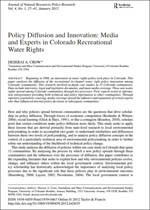 Abstract: Beginning in 1998, an innovation in water rights policy took place in Colorado. This paper analyses the diffusion of the recreational in-channel water right policy innovation among Colorado communities. This research involved in-depth case studies in 12 Colorado communities. Data include interviews, legal and legislative documents, and mass media coverage. These new water rights spread among Colorado communities through two processes. First, experts acted as information entrepreneurs providing both technical and policy information to other communities. Through repetitive journalistic sourcing, media coverage spread the influence and reputation of certain experts who then influenced internal policy decisions in subsequent communities. Read more ... Abstract: Beginning in 1998, an innovation in water rights policy took place in Colorado. This paper analyses the diffusion of the recreational in-channel water right policy innovation among Colorado communities. This research involved in-depth case studies in 12 Colorado communities. Data include interviews, legal and legislative documents, and mass media coverage. These new water rights spread among Colorado communities through two processes. First, experts acted as information entrepreneurs providing both technical and policy information to other communities. Through repetitive journalistic sourcing, media coverage spread the influence and reputation of certain experts who then influenced internal policy decisions in subsequent communities. Read more ...
Crow, D.A. and J.R. Stevens (2012), Citizen Engagement in Local Environmental Policy: Information, Mobilization, and Media. In H. Schachter & K. Yang (Ed.), The State of Citizen Participation in America 131-162, Information Age Publishing. [pdf].
 This book provides a state-of-the-art assessment of citizen participation practice and research in the United States. With contributions from a stellar group of scholars, it provides readers an overview of a field at the heart of democratic governance. Individual chapters trace shifts in participation philosophy and policy, examine trends at different government levels, analyze technology/participation interactions, identify the participation experiences of minority populations, and explore the impact of voluntary organizations on this topic. A five-chapter section illustrates innovative cases. Another section explores the role of various methodologies in advancing participation research. Read more ... This book provides a state-of-the-art assessment of citizen participation practice and research in the United States. With contributions from a stellar group of scholars, it provides readers an overview of a field at the heart of democratic governance. Individual chapters trace shifts in participation philosophy and policy, examine trends at different government levels, analyze technology/participation interactions, identify the participation experiences of minority populations, and explore the impact of voluntary organizations on this topic. A five-chapter section illustrates innovative cases. Another section explores the role of various methodologies in advancing participation research. Read more ...
Crow, D.A. and J.R. Stevens (2012), Local Science Reporting Relies on Generalists, Not Specialists. Newspaper Research Journal 33 (3), 35-48. [pdf].
 Excerpt: News media continue to serve a gatekeeping role in the filtration of civic information needed for deliberation and serve an almost exclusive role as the purveyors of science and technological information. Americans remain generally uninformed when it comes to even the most basic political and public policy issues, and because this trend holds consistent for basic civic knowledge, one can imagine that the average citizen is particularly ignorant when it comes to the awareness and understanding of science and technical issues. Although science writers once saw their craft improving in quality and quantity, a recent decline in the number of science writers in print and broadcast media has been observed. For example, in 2010 the U.S. National Association of Science Writers (NASW) reported a 10 percent decline in membership from the year before, attributing the change to declining economic conditions. Read more ... Excerpt: News media continue to serve a gatekeeping role in the filtration of civic information needed for deliberation and serve an almost exclusive role as the purveyors of science and technological information. Americans remain generally uninformed when it comes to even the most basic political and public policy issues, and because this trend holds consistent for basic civic knowledge, one can imagine that the average citizen is particularly ignorant when it comes to the awareness and understanding of science and technical issues. Although science writers once saw their craft improving in quality and quantity, a recent decline in the number of science writers in print and broadcast media has been observed. For example, in 2010 the U.S. National Association of Science Writers (NASW) reported a 10 percent decline in membership from the year before, attributing the change to declining economic conditions. Read more ...
Dilling, L. and E. Failey (2012), Managing Carbon in a Multiple Use World: The Implications of Land-Use Decision Context for Carbon Management. Global Environmental Change. [pdf].
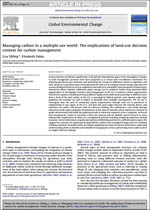 Abstract: Human land use contributes significantly to the growth of greenhouse gases in the atmosphere. Changes in land management practices have been proposed as a critical and cost-effective mechanism for reducing greenhouse gas emissions and promoting the storage of additional carbon in vegetation and soils. However, many discussions of the potential for land use to mitigate climate change only take into account biophysical factors such as vegetation and land cover and neglect how the agency of land owners themselves affects whether additional carbon storage can be achieved. Unlike many potential REDD opportunities in developing countries, land management in the US to enhance carbon sequestration would occur against a backdrop of clearly defined, legally enforceable land ownership. In addition, more than a third of the land surface in the US is managed by federal agencies who operate under legal guidelines for multiple use and is subject to demands from multiple constituencies. Read more ... Abstract: Human land use contributes significantly to the growth of greenhouse gases in the atmosphere. Changes in land management practices have been proposed as a critical and cost-effective mechanism for reducing greenhouse gas emissions and promoting the storage of additional carbon in vegetation and soils. However, many discussions of the potential for land use to mitigate climate change only take into account biophysical factors such as vegetation and land cover and neglect how the agency of land owners themselves affects whether additional carbon storage can be achieved. Unlike many potential REDD opportunities in developing countries, land management in the US to enhance carbon sequestration would occur against a backdrop of clearly defined, legally enforceable land ownership. In addition, more than a third of the land surface in the US is managed by federal agencies who operate under legal guidelines for multiple use and is subject to demands from multiple constituencies. Read more ...
Hale, B. (2012), Getting the Bad Out: Remediation Technologies and Respect for Others. Chapter in: W.P. Kabasenche, M. O’Rourke, and M.H. Slater (Ed.), The Environment: Philosophy, Science, and Ethics, pp. 223-243, MIT Press. [pdf].
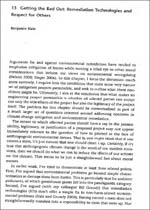 Excerpt: Arguments for and against environmental remediation have tended to stress mitigation of harms while turning a blind eye to other moral considerations that inform our views on environmental wrongdoing (Nelson 2008, Singer 2006). In this paper, I focus the discussion much more narrowly. I inquire into the conditions that make some very narrow set of mitigation projects permissible, and seek to outline what those conditions might be. Ultimately, I aim at the conclusion that what makes an engineering project permissible is whether all affected parties can accept not just the side effects of the project, but also the legitimacy of the project itself. The problem for this paper should be contextualized as part of a much larger project oriented around addressing concerns in climate change mitigation and environmental remediation. Read more ... Excerpt: Arguments for and against environmental remediation have tended to stress mitigation of harms while turning a blind eye to other moral considerations that inform our views on environmental wrongdoing (Nelson 2008, Singer 2006). In this paper, I focus the discussion much more narrowly. I inquire into the conditions that make some very narrow set of mitigation projects permissible, and seek to outline what those conditions might be. Ultimately, I aim at the conclusion that what makes an engineering project permissible is whether all affected parties can accept not just the side effects of the project, but also the legitimacy of the project itself. The problem for this paper should be contextualized as part of a much larger project oriented around addressing concerns in climate change mitigation and environmental remediation. Read more ...
Hale, B. (2012), The World That Would Have Been: Moral Hazard Arguments Against Geoengineering. Chapter in: C.J. Preston (Ed.), Engineering the Climate: The Ethics of Solar Radiation Management, pp. 113-131, Lexington Books. [pdf].
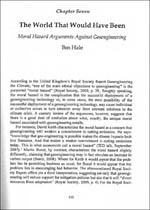 Excerpt: According to the United Kingdom’s Royal Society Report on Geoengineering the Climate, “one of the main ethical objections to geoengineering” is the purported “moral hazard” (Royal Society, 2009, p.39). Roughly speaking, the moral hazard is the complication that the successful deployment of a geoengineering technology, or in some cases the mere possibility of the successful deployment of a geoengineering technology, may cause individual or collective actors to turn attention away from alternate solutions to the climate crisis. A cursory review of the arguments, however, suggests that there is a good deal of confusion about what, exactly, the unique moral hazard associated with geoengineering entails. Read more ... Excerpt: According to the United Kingdom’s Royal Society Report on Geoengineering the Climate, “one of the main ethical objections to geoengineering” is the purported “moral hazard” (Royal Society, 2009, p.39). Roughly speaking, the moral hazard is the complication that the successful deployment of a geoengineering technology, or in some cases the mere possibility of the successful deployment of a geoengineering technology, may cause individual or collective actors to turn attention away from alternate solutions to the climate crisis. A cursory review of the arguments, however, suggests that there is a good deal of confusion about what, exactly, the unique moral hazard associated with geoengineering entails. Read more ...
Hale, B. (2012), The Veil of Opulence. New York Times, August 12. [read online].
 Excerpt: More than 40 years ago the philosopher John Rawls, in his influential political work “A Theory of Justice,” implored the people of the world to shed themselves of their selfish predispositions and to assume, for the sake of argument, that they were ignorant. He imposed this unwelcome constraint not so that his readers — mostly intellectuals, but also students, politicians and policy makers — would find themselves in a position of moribund stupidity but rather so they could get a grip on fairness. Read more ... Excerpt: More than 40 years ago the philosopher John Rawls, in his influential political work “A Theory of Justice,” implored the people of the world to shed themselves of their selfish predispositions and to assume, for the sake of argument, that they were ignorant. He imposed this unwelcome constraint not so that his readers — mostly intellectuals, but also students, politicians and policy makers — would find themselves in a position of moribund stupidity but rather so they could get a grip on fairness. Read more ...
|
Pielke, Jr., R. A. (2012), Mad Cows, Hurricane Sandy, and Why We Need Strong Science Assessors. Bridges 36 , Published December 2012. [read online].
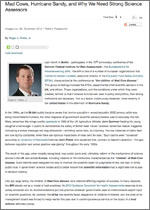 Excerpt: Last month in Berlin, I participated in the 10th anniversary conference of the German Federal Institute for Risk Assessment – the Bundesinstitut für Risikobewertung (BfR). The BfR is one of a number of European organizations that Catherine Geslain-Lanéelle, executive director of the European Food Safety Authority (EFSA), characterized at the conference as “the children of Mad Cow disease.” This group of siblings includes the EFSA, departmental chief scientific advisors in the UK, and others. These organizations, and the conditions under which they were created, remind us that if science is to be well used in policy and politics, then strong institutions are necessary. This is a lesson continuously relearned, most recently in the United States in the aftermath of Hurricane Sandy. Read more ... Excerpt: Last month in Berlin, I participated in the 10th anniversary conference of the German Federal Institute for Risk Assessment – the Bundesinstitut für Risikobewertung (BfR). The BfR is one of a number of European organizations that Catherine Geslain-Lanéelle, executive director of the European Food Safety Authority (EFSA), characterized at the conference as “the children of Mad Cow disease.” This group of siblings includes the EFSA, departmental chief scientific advisors in the UK, and others. These organizations, and the conditions under which they were created, remind us that if science is to be well used in policy and politics, then strong institutions are necessary. This is a lesson continuously relearned, most recently in the United States in the aftermath of Hurricane Sandy. Read more ...
Pielke, Jr., R. A. (2012), Science, Sex, and the Olympics. Bridges 34. [read online].
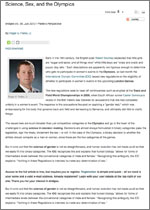 Excerpt: Early in the 19th century, the English poet Robert Southey explained that little girls are “sugar and spice, and all things nice” while little boys are “snips and snails and puppy dog tails.” Such descriptions are apparently not rigorous enough to determine who gets to participate in women’s events in the Olympics, so last month the International Olympic Committee (IOC) issued new regulations on the eligibility of athletes to participate in women’s events in the upcoming London Games.. Read more ... Excerpt: Early in the 19th century, the English poet Robert Southey explained that little girls are “sugar and spice, and all things nice” while little boys are “snips and snails and puppy dog tails.” Such descriptions are apparently not rigorous enough to determine who gets to participate in women’s events in the Olympics, so last month the International Olympic Committee (IOC) issued new regulations on the eligibility of athletes to participate in women’s events in the upcoming London Games.. Read more ...
Pielke, Jr., R. A. (2012), Climate of Failure. Foreign Policy, August 6. [read online].
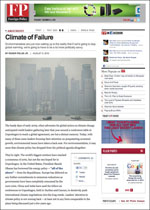 Excerpt: The heady days of early 2009, when advocates for global action on climate change anticipated world leaders gathering later that year around a conference table in Copenhagen to reach a global agreement, are but a distant memory. Today, with many of these same leaders focusing their attention on jumpstarting economic growth, environmental issues have taken a back seat. For environmentalists, it may seem that climate policy has dropped from the political agenda altogether. Read more ... Excerpt: The heady days of early 2009, when advocates for global action on climate change anticipated world leaders gathering later that year around a conference table in Copenhagen to reach a global agreement, are but a distant memory. Today, with many of these same leaders focusing their attention on jumpstarting economic growth, environmental issues have taken a back seat. For environmentalists, it may seem that climate policy has dropped from the political agenda altogether. Read more ...
Pielke, Jr., R.A. (2012), Basic Research as a Political Symbol. Minerva. [pdf].
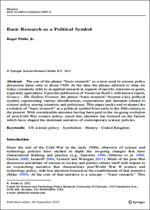 Abstract: The use of the phrase “basic research” as a term used in science policy discussion dates only to about 1920. At the time the phrase referred to what we today commonly refer to as applied research in support of specific missions or goals, especially agriculture. Upon the publication of Vannevar Bush’s well-known report, Science – The Endless Frontier, the phrase “basic research” became a key political symbol, representing various identifications, expectations and demands related to science policy among scientists and politicians. This paper tracks and evaluates the evolution of “basic research” as a political symbol from early in the 20th century to the present. With considerable attention having been paid to the on-going evolution of post-Cold War science policy, much less attention has focused on the factors which have shaped the dominant narrative of contemporary science policies. Read more ... Abstract: The use of the phrase “basic research” as a term used in science policy discussion dates only to about 1920. At the time the phrase referred to what we today commonly refer to as applied research in support of specific missions or goals, especially agriculture. Upon the publication of Vannevar Bush’s well-known report, Science – The Endless Frontier, the phrase “basic research” became a key political symbol, representing various identifications, expectations and demands related to science policy among scientists and politicians. This paper tracks and evaluates the evolution of “basic research” as a political symbol from early in the 20th century to the present. With considerable attention having been paid to the on-going evolution of post-Cold War science policy, much less attention has focused on the factors which have shaped the dominant narrative of contemporary science policies. Read more ...
Pielke, Jr., R. A. (2012), Hurricanes and Human Choice. Wall Street Journal, October. [read online].
 Excerpt: [W]ith respect to disasters we really do make our own luck. The relatively low number of casualties caused by Sandy is a testament to the success story that is the U.S. National Weather Service and parallel efforts of those who emphasize preparedness and emergency response in the public and private sectors. Everyone in the disaster-management community deserves thanks; the mitigation of the impacts from natural disasters has been a true national success story of the past century. Read more ... Excerpt: [W]ith respect to disasters we really do make our own luck. The relatively low number of casualties caused by Sandy is a testament to the success story that is the U.S. National Weather Service and parallel efforts of those who emphasize preparedness and emergency response in the public and private sectors. Everyone in the disaster-management community deserves thanks; the mitigation of the impacts from natural disasters has been a true national success story of the past century. Read more ...
Pielke, Jr., R. A. (2012), Technology Was the Key Factor in Saving the Ozone Layer. China Dialogue. [read online].
 Excerpt: Twenty five years ago, the Montreal Protocol on Substances that Deplete the Ozone Layer was introduced for signature by nations around the world. Since that time, the treaty has become arguably the most successful international environmental success story in history. It may also be the one which historians and policy analysts have argued about the most in an effort to draw lessons relevant to the climate debate. Read more ... Excerpt: Twenty five years ago, the Montreal Protocol on Substances that Deplete the Ozone Layer was introduced for signature by nations around the world. Since that time, the treaty has become arguably the most successful international environmental success story in history. It may also be the one which historians and policy analysts have argued about the most in an effort to draw lessons relevant to the climate debate. Read more ...
Schroeder, H., M. T. Boykoff, and L. Spiers (2012), Equity and State Representations in Climate Negotiations, Nature Climate Change. [read online].
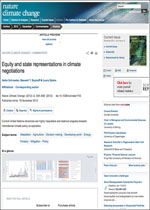 Abstract: We have entered an era where ecosystems are dominated by humans in a globalized, interconnected and interdependent world — the Anthropocene. Large-scale global environmental changes and their broader impacts transcend national boundaries and raise difficult issues of justice. This makes government interventions through conventional rulemaking highly problematic. Over the past five decades, multilateral institutions and global governance mechanisms have emerged to address those environmental challenges, but with mixed success. To avert irreversible global change, fundamental and radical transformations of existing governance practices are now needed. Indeed, state function has shifted from “a role based in constitutional powers toward a role of coordination and fusion of public and private resources,” where states have become “increasingly dependent on other social actors”. Also, the boundaries between who constitutes an ‘authorized’ representative (and who does not) and who has agency have shifted. Experts have explored the question of who are considered ‘expert’ or ‘authority’ agents to speak for the climate, and how they do so. Read more ... Abstract: We have entered an era where ecosystems are dominated by humans in a globalized, interconnected and interdependent world — the Anthropocene. Large-scale global environmental changes and their broader impacts transcend national boundaries and raise difficult issues of justice. This makes government interventions through conventional rulemaking highly problematic. Over the past five decades, multilateral institutions and global governance mechanisms have emerged to address those environmental challenges, but with mixed success. To avert irreversible global change, fundamental and radical transformations of existing governance practices are now needed. Indeed, state function has shifted from “a role based in constitutional powers toward a role of coordination and fusion of public and private resources,” where states have become “increasingly dependent on other social actors”. Also, the boundaries between who constitutes an ‘authorized’ representative (and who does not) and who has agency have shifted. Experts have explored the question of who are considered ‘expert’ or ‘authority’ agents to speak for the climate, and how they do so. Read more ...
This paper has received international media coverage:
Simmons, K. M., D. Sutter, and R. Pielke, Jr. (2012), Normalized Tornado Damage in the United States: 1950–2011. Environmental Hazards, December 5. [pdf].
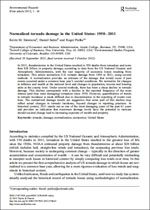 Abstract: In 2011, thunderstorms in the United States resulted in 550 deaths from tornadoes and more than $28 billion in property damage, according to data from the US National Oceanic and Atmospheric Administration, with the vast majority of economic losses resulting from tornadoes. This article normalizes US tornado damage from 1950 to 2011, using several methods. A normalization provides an estimate of the damage that would occur if past events occurred under a common base year’s societal conditions. We normalize for changes in inflation and wealth at the national level and changes in population, income and housing units at the county level. Under several methods, there has been a sharp decline in tornado damage. This decline corresponds with a decline in the reported frequency of the most intense (and thus most damaging) tornadoes since 1950. However, quantification of trends in tornado incidence is made difficult due to discontinuities in the reporting of events over time. The normalized damage results are suggestive that some part of this decline may reflect actual changes in tornado incidence, beyond changes in reporting practices. In historical context, 2011 stands out as one of the most damaging years of the past 61 years and provides an indication that maximum damage levels have the potential to increase should societal change lead to increasing exposure of wealth and property. Read more ... Abstract: In 2011, thunderstorms in the United States resulted in 550 deaths from tornadoes and more than $28 billion in property damage, according to data from the US National Oceanic and Atmospheric Administration, with the vast majority of economic losses resulting from tornadoes. This article normalizes US tornado damage from 1950 to 2011, using several methods. A normalization provides an estimate of the damage that would occur if past events occurred under a common base year’s societal conditions. We normalize for changes in inflation and wealth at the national level and changes in population, income and housing units at the county level. Under several methods, there has been a sharp decline in tornado damage. This decline corresponds with a decline in the reported frequency of the most intense (and thus most damaging) tornadoes since 1950. However, quantification of trends in tornado incidence is made difficult due to discontinuities in the reporting of events over time. The normalized damage results are suggestive that some part of this decline may reflect actual changes in tornado incidence, beyond changes in reporting practices. In historical context, 2011 stands out as one of the most damaging years of the past 61 years and provides an indication that maximum damage levels have the potential to increase should societal change lead to increasing exposure of wealth and property. Read more ...
|

















